Tomatoes, the vibrant and juicy garden favorites, play a significant role in our kitchens, backyards, and health.
But imagine waking up to find your thriving tomato plants wilting, their once lively green leaves eerily turning white.
Well, the tomato leaves turning white can be a gardener’s nightmare. White the leaves can be symptomatic of numerous problems, ranging from scorching sun exposure to nutrient imbalances or pesky pests.
However, fear not! Understanding these issues can often feel like trying to solve a botanical puzzle, but we’ve got you covered.
This article is your comprehensive guide to deciphering and tackling the enigma of white tomato leaves. We will delve into the common causes, diagnosis, treatments, and preventative measures.
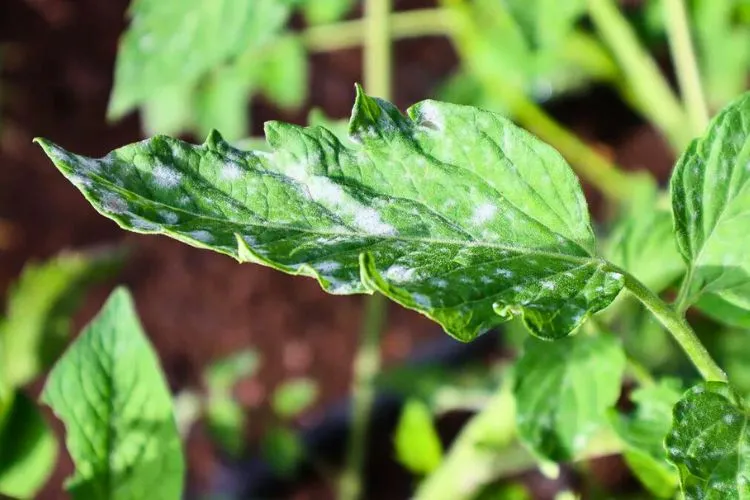
By the end, you’ll have a robust set of tools to ensure your tomatoes stay green, healthy, and productive. Let’s bring back the joy to your gardening experience!
Table of Contents
6 Common Causes of Tomato Leaves Turning White
Understanding the common causes behind your tomato leaves turning white is the first step to regaining control of your garden’s health.
The following section looks at the most frequent culprits – from intense sunlight exposure to pests and diseases. We’ll explain the impact of each issue and offer tips for prevention and management.
Knowledge is power, and with this section, you’ll be armed with the necessary information to identify and combat these problems head-on.
Ready to dive in? Let’s explore the world beneath the leaves!
Exposure to intense sunlight
A key component of plant growth is sunlight, yet too much of a good thing can be detrimental. The phenomenon known as sunscald is an effect of excessive sunlight.
It often turns white tomato leaves, indicating they have essentially received a sunburn. The intense light and heat can degrade chlorophyll, the pigment responsible for photosynthesis, and the plant’s vibrant green color, leading to a bleached appearance.
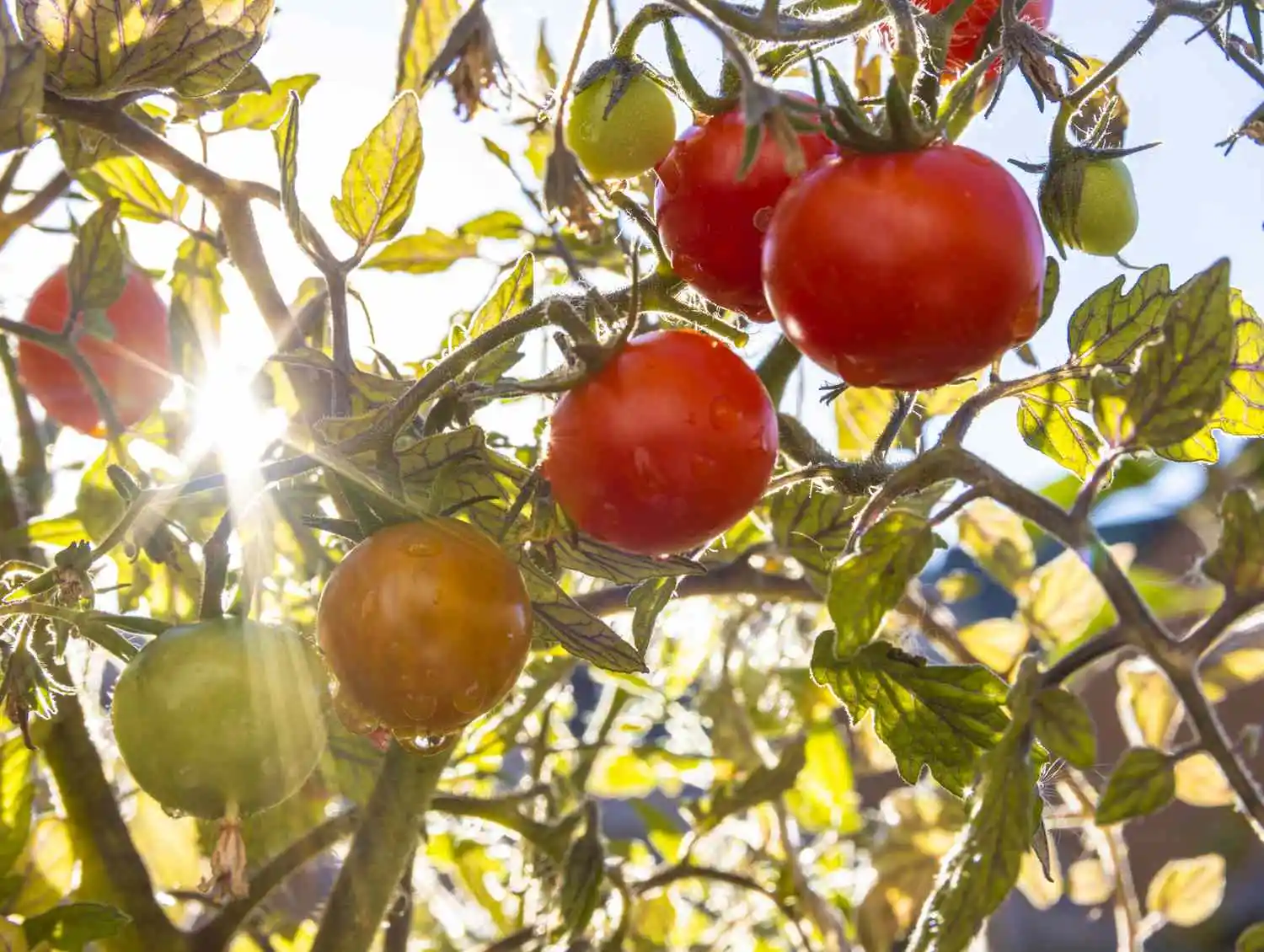
While some may think sunscald only affects the fruit, the intense rays can also harm the leaves. It can cause damage to the plant’s tissues, inhibiting its ability to carry out photosynthesis effectively and, ultimately, leading to decreased productivity.
Preventing sunscald involves adopting certain garden practices:
- Shade cloth: Employing a shade cloth during the peak hours of sunlight can significantly reduce the intensity of sun exposure, especially in the hot summer months.
- Strategic planting: Planting tall crops such as corn or sunflowers on the western edge of your garden can provide natural afternoon shade to your tomato plants.
- Proper watering: Keeping your plants hydrated helps them cope with intense sunlight. However, avoid watering in the peak afternoon sun to prevent magnified sunlight from burning the leaves.
- Mulching: Mulching around the base of the plant helps retain soil moisture and keeps the roots cool, increasing the plant’s resilience against sunscald.
Nutritional imbalances
Like us, plants also require a balanced diet. Too much or too little of any nutrient can throw a plant’s health off-kilter, leading to many problems, including the whitening of the leaves.
Overfertilization and Nutrient Burn
Overfertilization is common, especially when gardeners are too eager to boost their plant’s growth. This enthusiasm, however, can lead to nutrient burn.
Symptoms often include leaf curling, yellowing, browning at the tips, and even a whitish discoloration. The excessive nutrients in the soil can create a high salt concentration, which ‘burns’ the plant, affecting its water uptake and overall health.
Nutrient Deficiencies and Their Impact on Leaf Color
On the other hand, nutrient deficiencies, particularly magnesium, and nitrogen, can lead to a similar bleaching of leaves.
Magnesium deficiency usually manifests as yellowing leaves with green veins, while nitrogen deficiency leads to an overall paleness, as nitrogen is crucial for photosynthesis.
Recommended Fertilization Practices for Healthy Tomato Plants
The key to avoiding nutritional imbalances is adhering to a few recommended practices:
- Follow Instructions: Always adhere to the recommended dosage on fertilizer packages. More is not always better.
- Test Your Soil: This will provide you with an understanding of which nutrients your soil may lack or have in excess.
- Use Balanced Fertilizers: A balanced tomato-specific fertilizer will have appropriate nitrogen, phosphorous, and potassium mix. You can also add Epsom salts to your feeding routine to combat potential magnesium deficiencies.
- Practice Rotation and Companion Planting: Rotating crops and planting companions that replenish the soil, like beans or peas, can help maintain a healthy nutrient balance in your garden.
Cold temperatures and frost damage
Tomatoes are warm-season crops, so they are quite sensitive to cold temperatures and frost. When exposed to chilly weather, the plant’s cells can freeze and rupture, leading to damage that often manifests as whitening or browning of the leaves.
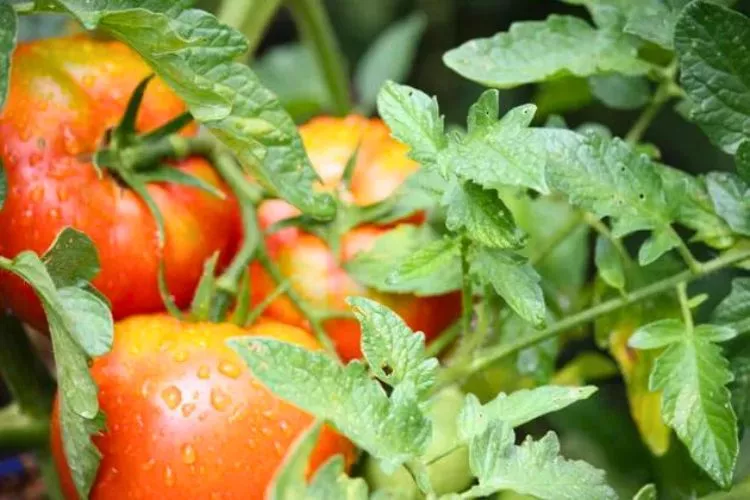
How Low Temperatures Affect Tomato Plants
Frost damage often starts at the tips and edges of the leaves, gradually spreading inwards. If left unchecked, it can kill entire branches or the whole plant. You might notice your tomato leaves turning white following a cold snap.
Protecting Tomato Plants from Frost
If you’re expecting a frost or a sudden drop in temperature, there are several measures you can take to protect your tomato plants:
- Cover Plants: Use frost blankets or even old bedsheets to cover your plants. Ensure the covering goes to the ground to trap heat radiating from the soil.
- Water the Soil: Water your garden before a frost, as wet soil retains more heat than dry soil.
- Cloches and Cold Frames: For young or particularly vulnerable plants, consider using cloches or cold frames, which provide a more secure environment against the cold.
- Choose Cold-Tolerant Varieties: If you live in a region with a short growing season or frequent cold snaps, consider planting cold-tolerant tomato varieties.
Here are some varieties of tomato plants that are known for their cold tolerance:
- Stupice Tomato: Native to the Czech Republic, this variety is highly valued for its cold tolerance. It also has the advantage of being an early producer.
- Oregon Spring Tomato: Developed at Oregon State University, this variety is tolerant to cold and wet climates, producing juicy, medium-sized tomatoes.
- Glacier Tomato: True to its name, this variety can withstand cooler temperatures and has a shorter maturation period, allowing you to harvest earlier in the season.
- Siberia Tomato: As the name suggests, this variety comes from Russia and can set fruit at very low temperatures.
- Sub Arctic Plenty Tomato: This is one of the world’s earliest maturing varieties, known for producing tomatoes in cool climates.
Planting unhardened seedlings
Starting tomatoes from seeds indoors can give them a head start, but it also brings the challenge of transition. Moving your seedlings straight from the cozy indoors to the great outdoors can shock their system, akin to jumping into a cold pool after a hot tub.
This sudden change in conditions can stress the plants, causing leaf discoloration.
Explanation of Hardening Off Process
This is where the process of ‘hardening off’ comes in. It’s a way to gradually acclimate your seedlings to outdoor conditions, reducing transplant shock and promoting healthier plants.
The process involves gradually exposing the seedlings to outdoor conditions over 7-10 days.
Steps to Properly Harden Off Tomato Seedlings
Here’s how you can harden off your tomato seedlings effectively:
- Start Gradually: Place your seedlings outdoors in a shaded or protected spot for an hour or two, then bring them back inside.
- Increase Exposure: Over the next week or so, gradually increase the time they spend outside and slowly introduce them to more sunlight.
- Monitor Weather Conditions: Avoid exposing seedlings to harsh conditions. Windy days, nights below 50°F (10°C), or hot and sunny afternoons can stress them.
- Gradual Sunlight Exposure: Start with dappled sunlight or morning sun to prevent sunscald, gradually increasing to more intense midday sun.
- Final Step: Before transplanting, leave the seedlings overnight for a few nights, but only if the temperatures stay above 50°F (10°C).
Pests and Fungal Diseases
Just as with us, pests and diseases can be a real bane to the health of plants. They can stress the plant, drain its resources, and cause all kinds of symptoms, including the whitening of leaves.
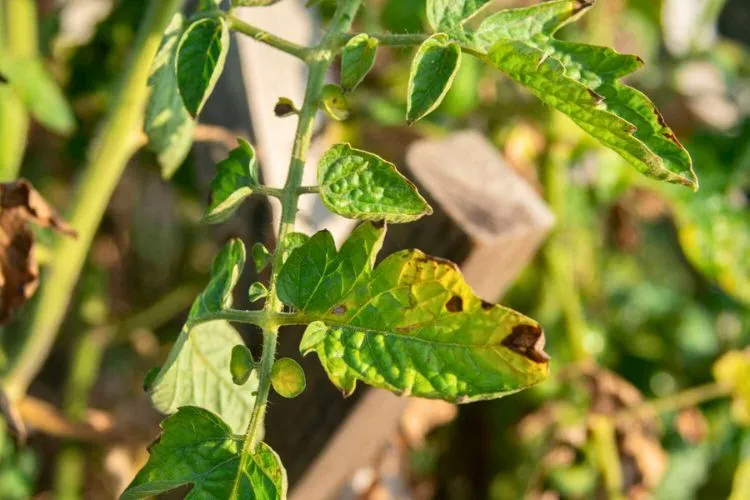
Common Pests That Can Cause This Issue
Certain pests can cause tomato leaves to turn white. These include spider mites and whiteflies. These tiny creatures suck sap from the plant, causing the leaves to lose their green color and turn a pale white or yellow.
Aphids can also cause similar damage, though they are more likely to cause yellowing than whitening.
Fungal Diseases and Their Effect on Tomato Leaves
Fungal diseases can also lead to tomato leaves turning white. Powdery mildew, for instance, causes a white, powdery coating on the leaves.
Another fungal pathogen, Fusarium, can cause a condition known as Fusarium wilt that can lead to pale leaves.
Common Fungal Diseases and Their Symptoms
Here are some common fungal diseases that affect tomato plants:
- Powdery Mildew: Causes a white, powdery substance on the leaves. Leaves may eventually turn yellow and die.
- Fusarium Wilt: Causes yellowing and wilting, starting with the lower leaves and moving upwards. The plant’s vascular tissue may also turn a dark color.
- Early Blight: Causes dark, circular spots with a bullseye-like pattern. The surrounding leaf area may turn yellow.
- Late Blight: Causes irregularly shaped, dark spots on leaves and stems. During humid conditions, a white, fuzzy growth may appear on the underside of the leaves.
Prevention and Control of Fungal Diseases
Preventing and controlling fungal diseases involves several strategies:
- Watering: Water your plants at the base to keep the leaves dry, as many fungi thrive in wet conditions.
- Air Circulation: Space your plants adequately to ensure good air circulation, which can help keep leaves dry.
- Cleanliness: Keep the garden free from fallen leaves and other debris, which can harbor fungal spores.
- Fungicides: Use a fungicide suitable for edible plants if fungal diseases have been a consistent problem in your garden.
Over-Fertilization
It might seem counterintuitive, but there is such a thing as too much love when fertilizing your tomato plants.
Over-fertilization, particularly with nitrogen-rich fertilizers, can lead to an excess of lush green growth at the expense of fruit production, and even worse, it can cause leaf burn, which may present as a whitening or yellowing of the tomato leaves.
When fertilizer is applied in too high quantities, the salts contained within can accumulate in the soil, leading to a toxic environment for the plants.
This “fertilizer burn” can cause the leaves to turn white, then brown as they die. Over time, it can severely damage or even kill the plant.
Therefore, adhering to the recommended rates when applying fertilizers is crucial. Remember, more is not always better.
If you’ve been over-generous with your fertilizing and notice your tomato leaves turning white, cease fertilizing immediately and thoroughly water your plants to help flush out the excess fertilizer.
You may need to replant into fresh, uncontaminated soil in severe cases.
Diagnosis and Treatment
Understanding the issue is the first step in solving it. In this section, we delve into the key indicators and symptoms to diagnose why your tomato leaves are turning white and, most importantly, the effective measures you can take to treat and revive your afflicted plants.
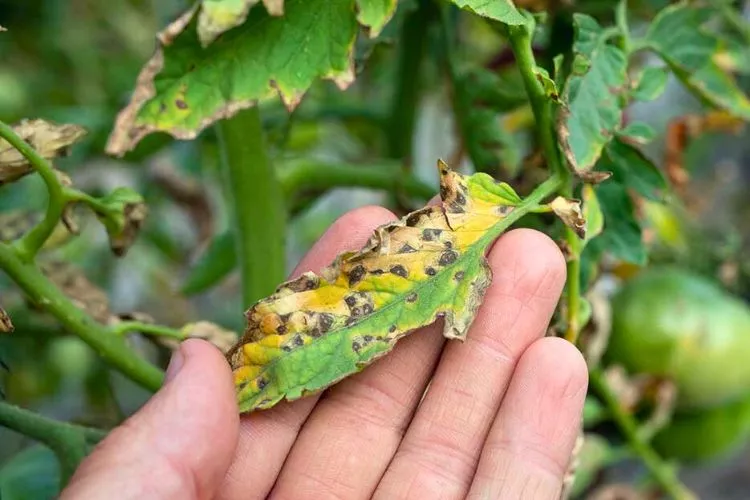
Identifying the underlying cause of white tomato leaves
To remedy white leaves on your tomato plants, it’s vital to identify the cause first. Doing so will allow you to apply the right treatment and prevent the issue from recurring.
Visual Symptoms and Leaf Examination
Your plants are pretty good at communicating their needs if you know what to look for. A careful examination of the affected leaves can give you crucial clues. If the leaves turn white uniformly, it’s likely a case of sunscald or possibly overexposure to frost.
If you observe a fine, white powder on the leaves, it’s probably a fungal disease like powdery mildew. White or yellow mottling may indicate an infestation of spider mites or whiteflies.
Inspecting the underside of the leaves can also be revealing. This is where pests like aphids and whiteflies often reside.
Common Signs of Nutrient Deficiencies
Nutrient deficiencies can also lead to discoloration of tomato leaves. If your plants show signs of stunted growth and the older leaves are turning yellow, then turning white, it could indicate a nitrogen deficiency.
On the other hand, a potassium deficiency may show as yellowing or browning at the tips and edges of leaves.
However, remember that multiple nutrient deficiencies can coexist, complicating the diagnosis. Therefore, consider a soil test if you suspect nutrient imbalance but can’t pinpoint the exact deficiency.
This can provide a comprehensive view of the nutrient availability in your soil and guide your fertilization practices.
Steps to rescue tomato plants with white leaves
Once the cause of the whitening leaves has been identified, it’s time to take action and nurse your plants back to health. Here’s how to do it:
Adjusting Watering Practices
Overwatering or underwatering can stress plants and exacerbate nutrient deficiencies or fungal diseases. If the soil is waterlogged, allow it to dry before watering again.
Conversely, if the soil is too dry, increase watering. Remember, it’s best to water deeply but infrequently to keep the soil moist but not waterlogged.
Removing Damaged Leaves and Branches
Pruning is a vital part of plant health. Removing the affected leaves and branches prevents the issue from spreading further into the plant. Use clean, sterilized pruning tools to avoid spreading diseases.
Implementing Proper Fertilization Techniques
If over-fertilization has caused the leaves to turn white, stop fertilizing and flush the soil with clean water to remove excess salts. If nutrient deficiency is the issue, apply a balanced tomato-specific fertilizer, following the manufacturer’s instructions closely.
Providing Adequate Shade and Protection
If your tomato plants have sunscald, providing shade can help prevent further damage. You can use shade cloths or plant taller crops on the western side to offer afternoon shade. For frost protection, consider using frost cloths or moving your plants indoors if they are in containers.
For pests or fungal diseases, consider using organic or synthetic pesticides or fungicides, always following the instructions on the label.
By taking these steps, you can bring your plants back to health and prevent future occurrences of white leaves. It’s all about responding promptly and adjusting your care routine as needed. Your plants will thank you for it!
Preemptive Measures for Healthy Tomato Plants
Prevention is always better than cure. Let’s look at some proactive steps you can take to ensure that your tomato plants remain vigorous and healthy, avoiding the issue of white leaves altogether. Get ready for a bountiful harvest!
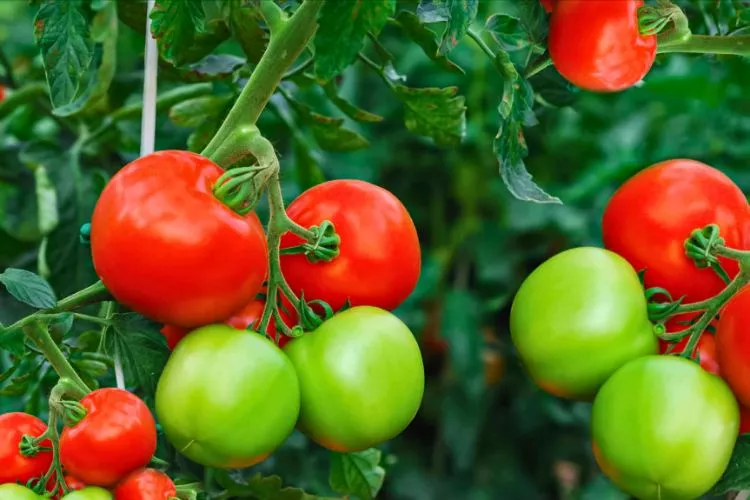
Site selection and soil preparation
Choosing the right site and preparing the soil can make a difference when it comes to successful tomato growing. Tomato plants prefer a well-draining site with at least six hours of direct sun daily.
The soil should be rich in organic matter, with a pH between 6.0 and 6.8. Amending your soil with compost or well-rotted manure can help improve its fertility and structure.
Rotating your tomato plants to a new garden area each year can also help prevent the buildup of soil-borne diseases.
Correct watering strategies
Watering is a bit of an art form, and understanding the needs of your tomato plants is key. Tomatoes prefer deep, infrequent watering over daily light watering.
This encourages roots to grow deeper into the soil, making plants more drought-resistant. Avoid overhead watering to reduce the spread of fungal diseases.
Instead, water is at the base of the plant, ideally early in the day, so any excess moisture on the foliage can evaporate before nightfall.
Proper fertilization techniques
While tomatoes are heavy feeders, a balanced approach to fertilization is best. Too much nitrogen can lead to lush foliage but fewer fruits, while too little can lead to yellowing leaves.
A slow-release, all-purpose vegetable fertilizer is a great choice. Adding some organic matter, such as compost or well-rotted manure, is also beneficial to the soil before planting. This feeds your plants and improves soil health, creating a better environment for your tomatoes to thrive in.
Implementing sun protection measures
While tomatoes love the sun, too much of a good thing can lead to sunscald, causing leaves to turn white. If your plants are in an area of the garden that receives intense midday sun, consider using shade cloth to provide some relief during the hottest part of the day.
Another strategy is to plant taller crops to the west of your tomatoes, protecting them from the intense afternoon sun.
Frequently Asked Questions (fAQs)
Why are my tomato plant leaves turning silver?
Tomato leaves might turn silver due to issues like sunscald, over-fertilization, cold damage, pests, fungal diseases, or nutrient deficiencies. It’s essential to identify the root cause for proper treatment.
How can I fix white leaves on tomato plants?
Corrective measures depend on the cause: adjust watering, remove damaged leaves, apply proper fertilizer, and provide shade for sunscalds. For pests and diseases, apply suitable organic or synthetic treatments.
Is there a home remedy for white spots on tomato leaves?
A mild soap and water mixture can help deal with pests causing white spots. Home remedies like baking soda spray or milk and water mixture can be effective for fungal issues. Always test on a small area first.
Conclusion:
In conclusion, maintaining vibrant, healthy tomato plants requires mindful attention to their care. Issues like sunscald, nutritional imbalances, frost damage, pests, and diseases can be the causes of your tomato leaves turning white.
Early detection and proactive measures like proper site selection, watering, fertilization, and sun protection can prevent these problems.
Remember, a healthy plant starts with careful, informed gardening. We hope that this guide has been helpful. You can read about similar topics here on our website. Check back again soon for more.


